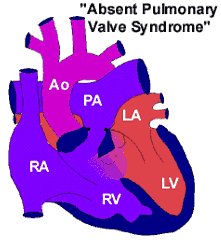Absent pulmonary valve is a rare defect in which the pulmonary valve that carries oxygen-poor blood from the heart to the lungs is either missing or poorly formed. This condition is present at birth (congenital).
Alternative Names
Absent pulmonary valve syndrome; Congenital absence of the pulmonary valve; Pulmonary valve agenesis
Causes, incidence, and risk factors
 Absent pulmonary valve occurs when the pulmonary valve doesn’t form or develop properly while the baby is in the mother’s womb. It often occurs as part of a rare condition called tetralogy of Fallot.
Absent pulmonary valve occurs when the pulmonary valve doesn’t form or develop properly while the baby is in the mother’s womb. It often occurs as part of a rare condition called tetralogy of Fallot.
When the pulmonary valve is missing or does not work well, not enough blood can flow to the lungs to get oxygen.
There is also usually a hole between the left and right ventricles of the heart (ventricular septal defect). This defect will also lead to low-oxygen blood being pumped out to the body.
The skin will have a blue appearance (cyanosis), because the body’s blood contains a low amount of oxygen.
Absent pulmonary valve also results in very enlarged (dilated) branch pulmonary arteries (the arteries that carry blood to the lungs). They can become so enlarged that they press on the tubes that bring air to the lungs (bronchi) and cause breathing problems.
Other heart defects that can occur with absent pulmonary valve include:
* Abnormal tricuspid valve
* Atrial septal defect
* Double outlet right ventricle
* Ductus arteriosis
* Endocardial cushion defect
* Marfans syndrome
* Tricuspid atresia
Heart problems that occur with absent pulmonary valve may be due to defects of the genes (chromosomes).
Symptoms
Symptoms can vary depending on which other defects the infant has, but may include:
* Blue coloring to the skin (cyanosis)
* Coughing
* Rapid breathing
* Respiratory failure
* Wheezing
Signs and tests
Absent pulmonary valve may be diagnosed before the baby is born with a test that uses sound waves to create an image of the heart (echocardiogram).
During an examination, the doctor may hear a murmur in the infant’s chest.
Tests for absent pulmonary valve include:
* A test to measure the electrical activity of the heart (electrocardiogram)
* Chest CT scan
* Chest x-ray
* Echocardiogram
* Magnetic resonance imaging (MRI) of the heart
Treatment
Infants who have breathing symptoms should have surgery as quickly as possible. Even infants without symptoms should have surgery within the first 3-6 months of life.
Depending on the type of heart defects the infant has, surgery may involve:
* Closing the hole in the wall between the left and right ventricles of the heart (ventricular septal defect)
* Correcting a blood vessel that connects the aorta of the heart to the pulmonary artery (ductus arteriosis)
* Enlarging the flow from the right ventricle to the lungs
Types of surgery for absent pulmonary valve include:
* Moving the pulmonary artery to the front of the aorta and away from the airways
* Rebuilding the artery wall in the lungs to reduce pressure on the airways (reduction pulmonary arterioplasty)
* Rebuilding the windpipe and breathing tubes to the lungs
* Replacing the abnormal pulmonary valve with one taken from human or animal tissue
Infants with severe breathing symptoms may need to get oxygen or be put on a breathing machine.
Expectations (prognosis)
Without surgery, most infants who have severe lung complications will die.
Surgery can treat the condition and relieve symptoms in many cases.
Complications
* Brain infection (abscess)
* Lung collapse (atelectasis)
* Pneumonia
* Right-sided heart failure
* Stroke
Calling your health care provider
Call your health care provider if your infant has symptoms of absent pulmonary valve. If you have a family history of heart defects, talk to your doctor before or during pregnancy.
Prevention
There is no way to prevent this condition; however, families can have genetic testing to determine their risk of certain related heart defects.
References
Park, MK. Park: Pediatric Cardiology for Practitioners. 5th ed. Philadelphia, Pa: Mosby; 2008.
Nölke L, Azakie A, Anagnostopoulos PV, Alphonso N, Karl TR. The Lecompte maneuver for relief of airway compression in absent pulmonary valve syndrome. Ann Thorac Surg, 2006;81:1802-1807.
Brown JW, Ruzmetov M, Vijay P, Rodefeld MD, Turrentine MW. Surgical treatment of absent pulmonary valve syndrome associated with bronchial obstruction. Ann Thoracic Surg, 2006;82:2221-2226.
Credit: christushealth.org
